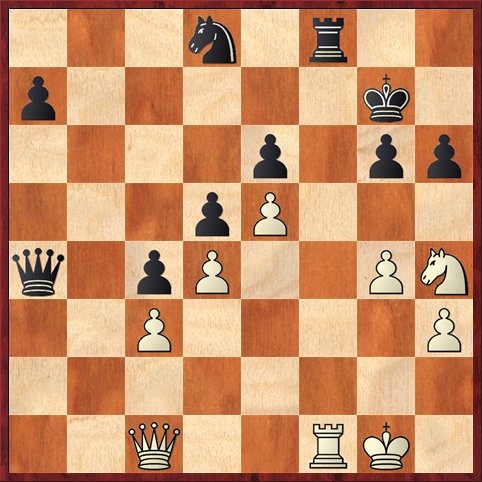Recently Dave Vigorito gave a ChessLecture that called “Not Quite an Agony Game” where he showed a recent game he lost against Raymond Kaufman. Dave mentioned at one point that it was his first tournament loss since his last “agony game” lecture, and between the two games he had played 32 straight games without losing. Of course, Vigorito had a long way to go before he could challenge the all-time record, held by Mikhail Tal, of 95 consecutive non-losing games. (Recently Wang Yue of China made a good run at Tal’s record, going 85 straight games without a defeat.)
I’m very impressed by people who almost never lose. I seldom even make it through one tournament without a loss. This is partly because I usually play pretty sharp chess, and also because I often self-destruct in time trouble.
In the Peoples Tournament, though, I have so far managed to avoid self-destruction. After my first-round win over Michael Aigner, I have played three consecutive draws against Yian Liou, Samuel Sevian, and Arjoe Loanzon. It’s been a somewhat unexciting tournament, but really there is nothing wrong with playing a draw against good opponents. That’s how Vigorito, Tal, and Yue built their non-losing streaks.
I did have a close call this evening, where I just barely managed to save a draw from a better position. On the last move of the time control (move 30) I foolishly sacrificed a pawn because I thought it would expose Loanzon’s king to an attack. Generally speaking, sacrificing material in time pressure is not a good thing to do. It turned out that I missed a zwischenzug that put me in serious trouble. Nevertheless, my intuitive sense that his king was too vulnerable turned out to be correct:
Quiz: What would White’s best move be after 33. … Qe8?
Here Loanzon has just taken on a4, and I have just played 33. Nh4. He thought for about half an hour here, but could not find a way to keep my queen and knight from infiltrating. White’s main threat is to take on f8 and then on h6. The move 33. … Rxf1+ 34. Qxf1 doesn’t help, because he can’t keep my queen out of f6. If 34. … Nf7 I can even draw immediately with 35. Nxg6! This theme reminds me a little bit of the famous Botvinnik-Capablanca game where Capa had his queen stranded on the queenside — although Botvinnik won that game, and I’m only drawing here.
Another reasonable attempt for Black is 33. … Qe8. This is the move that my opponent was thinking so long about. I was really hoping for this move, because I think White is almost winning. The key shot is 34. Rf6!, threatening to take on g6. 34. … Rxf6 35. ef+ is forced. Now if 35. … Kxf6 36. Qxh6 Black is in great danger. If 35. … Kh7 White wins with 36. Qa3! and Qe7 next move. I have to admit that I did not see 36. Qa3, but only because I hadn’t analyzed 35. … Kh7. If we had gotten to this position in the game, I think I probably would have seen it.
Since he couldn’t risk going into a losing position, Loanzon finally decided to play the drawing line, 33. … g5 34. Rxf8 Kxf8 35. Qf1+ Ke8 36. Ng6! (threatening a big check on f8) 36. … Qa3 37. Qf6! The knight and queen are too strong, and Black is forced to bail out into a perpetual check with 37. … Qc1+ etc.
On one hand I felt good about this nice tactical save. On the other hand, I can’t feel too happy about it because there was absolutely no reason for me to be in trouble to begin with. As in most draws, it depends on whether you want to see the glass as half empty or half full.



